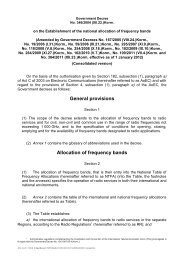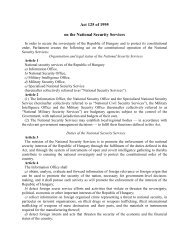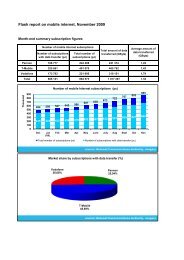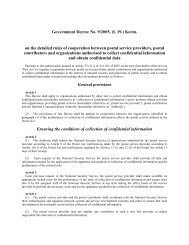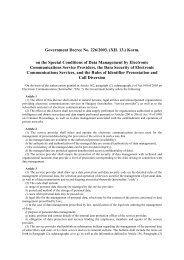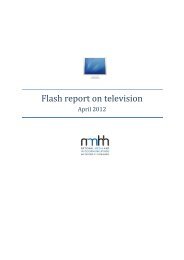The Hungarian Communications Market Developments and ...
The Hungarian Communications Market Developments and ...
The Hungarian Communications Market Developments and ...
Create successful ePaper yourself
Turn your PDF publications into a flip-book with our unique Google optimized e-Paper software.
22 23<br />
<strong>The</strong>re is the possibility of publicly disclosing information related to<br />
the obligations of an unlawful market player: the Authority may make<br />
public any information obtained during fact-finding investigations,<br />
may publish its decision in a national newspaper at the cost of the<br />
party violating the law, <strong>and</strong> obligate the service provider concerned<br />
to publish a correction. In 2008, some of the above instruments were<br />
occasionally resorted to <strong>and</strong> as of 2009 the Authority also intends to<br />
use these means in justifiable cases, by drawing on the experience<br />
gathered from imposing penalties in previous years.<br />
Figure 2.3: Changes in the number of consumer complaints<br />
lodged to service providers (per 1000 subscribers)<br />
pcs<br />
300<br />
200<br />
100<br />
0<br />
2007 average:<br />
118<br />
38<br />
Source: NHH<br />
32<br />
Mobile<br />
phone<br />
347<br />
141<br />
Fixed<br />
telephone<br />
Internet<br />
2006<br />
2007<br />
Broadcasting<br />
(cable tv)<br />
<strong>The</strong> Authority has used publicity as a kind of regulatory tool in<br />
other ways as well. Since 2007, based upon a Government Decree 23<br />
giving authorization to do so, the Authority has published analyses<br />
as regards the quality indicators of subscriber contracts, based upon<br />
data supplied by service providers. In the future the Authority intends<br />
156<br />
235<br />
116<br />
64<br />
to regularly publish such important indicators for informational<br />
purposes. Service provider <strong>and</strong> authority data demonstrate that<br />
the complaints <strong>and</strong> problems are mostly related to fixed-location<br />
telephone services rather than to mobile services. (<strong>The</strong> diagram<br />
showing the distribution of complains submitted only feature those<br />
resulting in authority procedures.)<br />
<strong>The</strong> decrease in the number of reports submitted to the authority<br />
is attributable to the transformed procedural model, on the one h<strong>and</strong><br />
<strong>and</strong> to the development of customer service, on the other h<strong>and</strong>.<br />
While earlier almost all consumer complains to the Authority brought<br />
about Authority procedures, today, a part of such complaints can<br />
be h<strong>and</strong>led by means of proper information service, with individual<br />
infringements to be now h<strong>and</strong>led in ex officio procedures.<br />
Between 1 January 2004 <strong>and</strong> 10 September 2008, the Authority issued<br />
more than 3,500 final decisions <strong>and</strong> over 300 notices. Experiences<br />
show that in the case of electronic communications services most problems<br />
arise in connection with the general terms of contract (modification,<br />
content <strong>and</strong> the publication thereof), the bills issued, the h<strong>and</strong>ling<br />
of complaints by service providers <strong>and</strong> individual subscriber contracts.<br />
Furthermore, typical infringement includes the non-performance<br />
of statutory data supply obligations. Although billing problems<br />
frequently occurred, the h<strong>and</strong>ling of a considerable part of such<br />
complaints does not fall within the competence of the Authority.<br />
<strong>The</strong> Authority had to make decisions in several issues over the<br />
past five years. In 2004 <strong>and</strong> 2005, penalties had to be imposed<br />
on several service providers for not complying with the reporting<br />
obligation towards the Authority as regards the general terms of<br />
contract <strong>and</strong> the rules of supplying information to subscribers. <strong>The</strong>se<br />
are serious infringements as the general terms of contract are an<br />
obligatory system of contractual terms for the regulation of the legal<br />
relationship between service providers <strong>and</strong> subscribers, aiming at<br />
guaranteeing the enforcement of the statutory principles as regards<br />
the protection of consumer interests.<br />
Figure 2.4: Complains submitted broken down by service area<br />
pcs<br />
1411<br />
2004<br />
1200<br />
2005<br />
936<br />
919<br />
2006<br />
800<br />
711<br />
621<br />
709<br />
2007<br />
2008<br />
400<br />
342<br />
200<br />
460<br />
405<br />
187<br />
110<br />
456<br />
453<br />
294<br />
253<br />
304<br />
312<br />
151<br />
131<br />
174<br />
222<br />
144<br />
114<br />
68<br />
0<br />
Fixed telephone Mobile Internet Broadcasting Post<br />
Source: NHH




